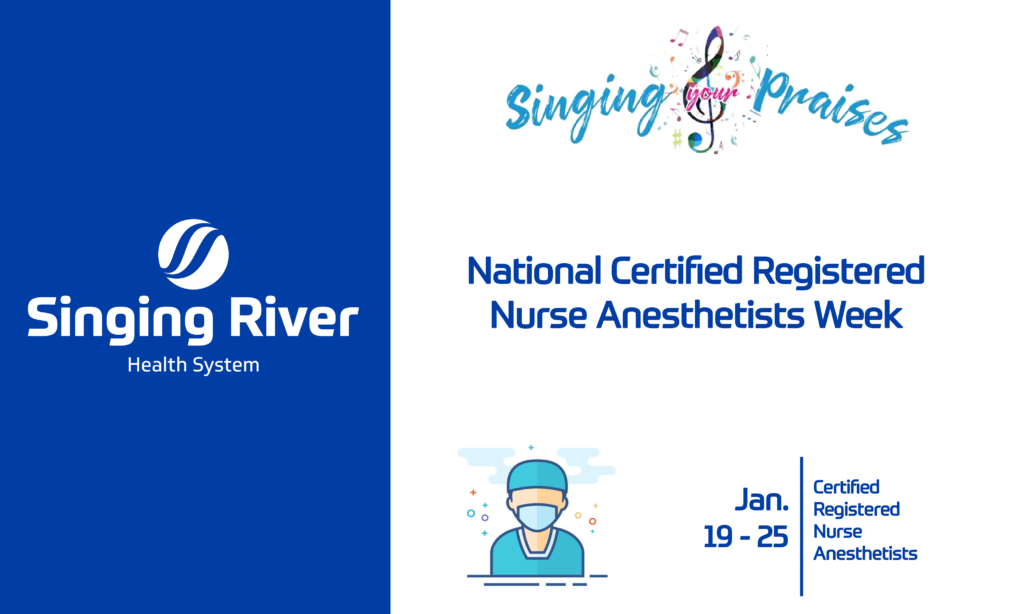Celebrating National CRNA Week

Singing Praises to our fantastic team of CRNAs (Certified Registered Nurse Anesthetists) for their careful work in keeping guests safe, comfortable, and feeling at ease throughout their journey with us!
What is a CRNA?
A Certified Registered Nurse Anesthetist (CRNA) administers anesthesia for all types of surgical cases, from the simplest to the most complex.
History of CRNAs
Nurse anesthetists have been providing anesthesia care to patients in the United States for more than 150 years. The CRNA (Certified Registered Nurse Anesthetist) credential came into existence in 1956, creating the official titles Nurse Anesthesiologist or Nurse Anesthetist.
CRNAs in the US
CRNAs are anesthesia professionals who safely administer more than 49 million anesthetics to patients each year in the United States, according to the American Association of Nurse Anesthetists (AANA) 2019 Member Profile Survey.
The practice of anesthesiology for CRNAs and physician anesthesiologists includes, but is not limited to:
- Patient care before, during and after surgery
- Patient care before, during and after labor and delivery
- Diagnostic and therapeutic procedures
- Trauma stabilization and critical care interventions
- Acute and chronic pain management
- Management of systems and personnel that support these activities
These skills and responsibilities fall within the scope of practice of both CRNAs and physician anesthesiologists, regardless of credentials.
Anesthesia Safety
According to a 1999 report from the Institute of Medicine, anesthesia care is nearly 50 times safer than it was in the early 1980s. Numerous outcomes studies have demonstrated that there is no difference in the quality of care provided by CRNAs and their physician counterparts.
Practice of Nursing
CRNAs provide anesthesia in collaboration with surgeons, dentists, podiatrists, anesthesiologists, and other qualified healthcare professionals. When anesthesia is administered by a nurse anesthetist, it is recognized as the practice of nursing; when administered by a physician anesthesiologist, it is recognized as the practice of medicine. Regardless of whether their educational background is in nursing or medicine, all anesthesia professionals give anesthesia the same way.
Autonomy and Responsibility
As advanced practice registered nurses, CRNAs practice with a high degree of autonomy and professional respect.
Practice Settings
CRNAs practice in every setting in which anesthesia is delivered: traditional hospital surgical suites and obstetrical delivery rooms; critical access hospitals; ambulatory surgical centers; the offices of dentists, podiatrists, ophthalmologists, plastic surgeons, and pain management specialists; and the U.S. military, Public Health Services, and Department of Veterans Affairs healthcare facilities.
Rural America
CRNAs are the primary providers of anesthesia care in rural America, enabling healthcare facilities in these medically under served areas to offer obstetrical, surgical, pain management and trauma stabilization services.
Military Presence
Nurses first provided anesthesia on the battlefields of the American Civil War. During WWI, nurse anesthetists became the predominant providers of anesthesia care to wounded soldiers on the front lines; today, CRNAs continue to be the primary providers of anesthesia care to U.S. military personnel on front lines, navy ships, and aircraft evacuation teams around the globe.
Cost-Efficiency
Managed-care plans recognize CRNAs for providing high-quality anesthesia care with reduced expenses to patients and insurance companies. The cost-efficiency of CRNAs helps control escalating healthcare costs.
CRNA Education Requirements
The minimum education and experience required to become a CRNA include**:
- A baccalaureate or graduate degree in nursing or other appropriate major.
- An unencumbered license as a registered professional nurse and/or APRN in the United States or its territories and protectorates.
- A minimum of one-year full-time work experience, or its part-time equivalent, as a registered nurse in a critical care setting within the United States, its territories, or a U.S. military hospital outside of the United States. The average experience of RNs entering nurse anesthesia educational programs is 2.9 years.
- Graduation with a minimum of a master’s degree from a nurse anesthesia educational program accredited by the Council on Accreditation of Nurse Anesthesia Educational Programs. As of August 2019, there were 121 accredited nurse anesthesia programs in the United States and Puerto Rico utilizing 1,870 active clinical sites; 91 nurse anesthesia programs are approved to award doctoral degrees for entry into practice.***
- Nurse anesthesia programs range from 24-51 months, depending on university requirements. Programs include clinical settings and experiences. Graduates of nurse anesthesia educational programs have an average of 9,369 hours of clinical experience.
- Some CRNAs pursue a fellowship in a specialized area of anesthesiology such as chronic pain management following the attainment of their degree in nurse anesthesia.
CRNA Certification
Before they can become CRNAs, graduates of nurse anesthesia educational programs must pass the National Certification Examination.
**Nurse anesthesia educational programs have admission requirements in addition to the above minimums.
*** Beginning Jan. 1, 2022, all students matriculating into an accredited program must be enrolled in a doctoral program.